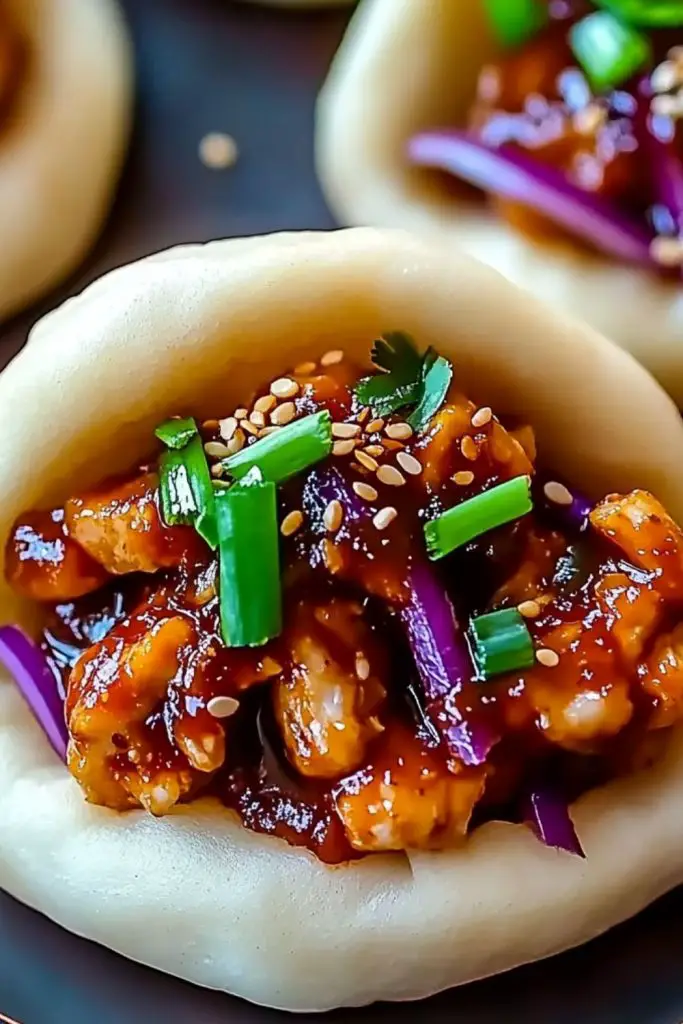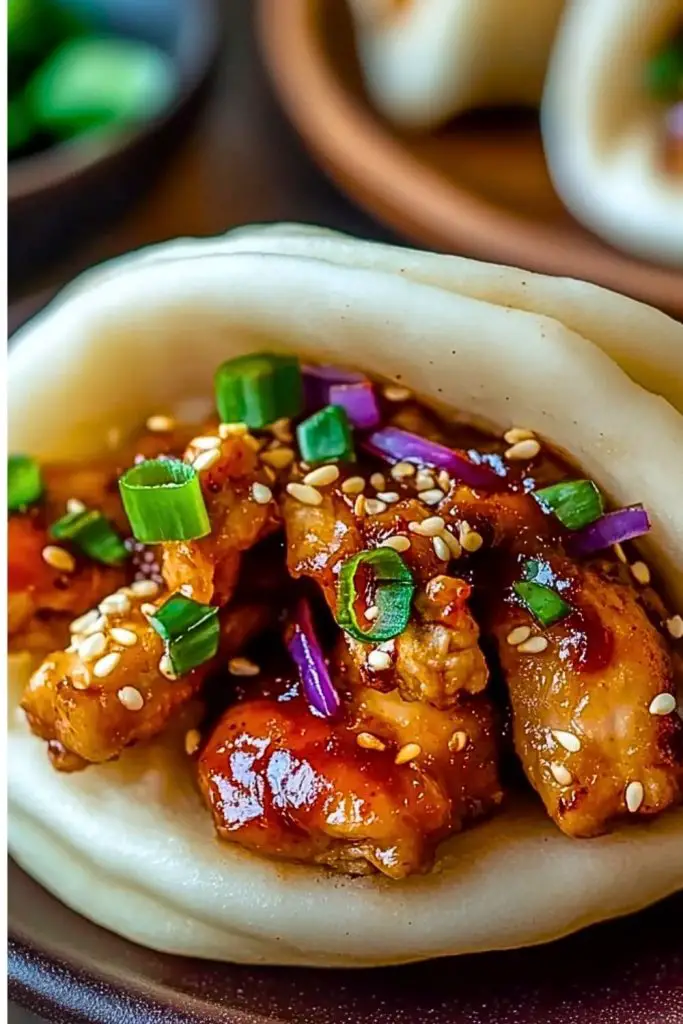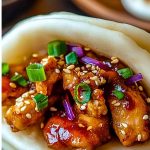Imagine biting into a cloud—soft, warm, and pillowy—only to be met with a bold explosion of sweet, spicy, and savory flavors. That’s the magic of Korean Chicken Bao. This dish combines the fluffy texture of steamed bao buns with sticky gochujang-glazed chicken, fresh green onions, and toasted sesame seeds, bringing Korean street food to your kitchen with elegance and heat.

Korean Chicken Bao is more than just a trendy treat—it’s a culinary journey. Whether you’re looking to impress at your next dinner party or searching for a bold new weeknight recipe, these bao buns deliver on both flavor and flair. With a balance of umami, spice, and subtle sweetness, each bite is an adventure. They’re also fun to assemble, making them a fantastic family or party dish.
Why You’ll Love This Korean Chicken Bao Recipe
- Flavor Explosion: A perfect marriage of Korean BBQ-style spice and sweetness.
- Soft Meets Crunch: The contrast between pillowy bao buns and sticky, crispy-edged chicken is irresistible.
- Versatile Dish: Works great as a starter, main course, or party finger food.
- Interactive Experience: Fun to build with friends and family—perfect for hosting.
- Customizable: Add pickled veggies, cucumbers, or even switch up the protein.
Preparation Phase & Tools to Use (Essential Tools and the Importance of Each)
To create the perfect Korean Chicken Bao, preparation and the right tools make all the difference. Here’s what you’ll need and why each tool matters:
Essential Tools & Equipment
- Steamer Basket (Bamboo or Metal)
This is non-negotiable. Steaming is the secret to achieving that soft, tender bao texture. Bamboo steamers absorb excess moisture, preventing soggy buns. - Stand Mixer with Dough Hook or Mixing Bowl
For making the bao dough, a stand mixer saves time and ensures an even knead. If mixing by hand, a large sturdy bowl will do—just be ready for a mini arm workout! - Rolling Pin
You’ll need this to flatten the dough into even rounds before steaming. Consistency helps them cook evenly. - Cast Iron or Nonstick Skillet
Ideal for searing the chicken until caramelized and crispy on the edges. A heavy pan ensures even cooking and locks in that flavor. - Measuring Cups & Spoons
Precision matters in balancing the sweet, spicy, and umami-rich sauce, so don’t eyeball it. - Tongs or Silicone Spatula
These are handy for tossing the chicken in sauce and assembling the bao without tearing them. - Sharp Knife & Cutting Board
Essential for prepping green onions, red onions, and slicing the chicken to the perfect size.
Preparation Tips
- Use Warm Water for the Dough
This activates the yeast effectively. Too hot and it kills it, too cold and it won’t activate. - Let the Dough Rise in a Warm Place
If your kitchen is cold, place the dough in the oven with just the light on. A consistent rise gives the bao its signature fluffiness. - Slice Chicken Thinly Against the Grain
This keeps it tender and allows it to soak up the sauce better. - Make the Sauce in Advance
Giving the gochujang-based sauce time to rest enhances its flavor. A few hours in the fridge can deepen the taste. - Steam with Parchment Paper
Cut small squares of parchment under each bao to prevent sticking and tearing. - Do Not Overcrowd the Steamer
Bao expand while steaming. Give them space to puff up properly without sticking together.
Ingredients for This Korean Chicken Bao Recipe
Creating Korean Chicken Bao from scratch is all about balancing bold flavors with the soft, delicate texture of bao buns. Below is a breakdown of everything you’ll need for both the bao and the savory Korean chicken filling.
For the Bao Buns
- 2 cups all-purpose flour
- 2 tablespoons sugar
- 1 teaspoon instant yeast
- 1/2 cup warm water (around 100°F / 38°C)
- 2 tablespoons milk
- 1 tablespoon vegetable oil (plus more for brushing)
- 1/4 teaspoon baking powder
- Pinch of salt
For the Korean Chicken Filling
- 1 lb (450g) boneless, skinless chicken thighs or breast, sliced thin
- 1 tablespoon vegetable oil (for cooking)
- 2 cloves garlic, minced
- 1 teaspoon fresh ginger, grated
- 2 tablespoons gochujang (Korean chili paste)
- 1 tablespoon soy sauce
- 1 tablespoon rice vinegar
- 1 tablespoon honey or brown sugar
- 1 teaspoon sesame oil
For Toppings & Garnish
- 2 green onions, finely sliced
- Thinly sliced red onions (optional but recommended for crunch)
- Toasted sesame seeds
- Fresh cilantro or pickled cucumbers (optional for extra freshness)

Step 1: Make the Bao Dough
- In a large mixing bowl (or stand mixer), combine the flour, sugar, instant yeast, and a pinch of salt.
- In a separate bowl, mix the warm water, milk, and vegetable oil. Slowly pour the liquid into the dry ingredients while mixing.
- Knead the dough for 8–10 minutes until it becomes smooth and elastic. If using a stand mixer, use the dough hook attachment.
- Cover the bowl with a damp cloth or plastic wrap and let it rise in a warm place for 1–1.5 hours, or until doubled in size.
Step 2: Prepare the Chicken Marinade
- In a small bowl, whisk together gochujang, soy sauce, rice vinegar, honey (or brown sugar), sesame oil, garlic, and ginger.
- Pour the marinade over the sliced chicken and mix to coat thoroughly.
- Cover and refrigerate for at least 30 minutes (or up to 2 hours for more flavor).
Step 3: Shape and Steam the Bao
- Once the dough has risen, punch it down and divide it into 8 equal pieces.
- Roll each piece into an oval shape, around 1/4 inch thick.
- Lightly brush the top with oil, then fold each oval in half to form the classic bao shape.
- Place each bao on a square of parchment paper.
- Cover and let them rest for 15 minutes while the steamer heats up.
- Steam the bao over boiling water for 10 minutes with the lid on. Do not open during steaming!
Step 4: Cook the Chicken
- Heat vegetable oil in a cast iron or nonstick skillet over medium-high heat.
- Add the marinated chicken and cook for 4–6 minutes per side, or until caramelized and cooked through.
- Reduce heat and pour in any remaining marinade, letting it simmer until thick and sticky.
- Stir to coat the chicken evenly.
Step 5: Assemble the Bao
- Gently open each bao and fill with a generous scoop of the spicy Korean chicken.
- Top with sliced green onions, red onions, and sesame seeds.
- Add extras like pickled cucumbers or cilantro if desired.
Notes
- Bao Dough Texture: The dough should be soft but not sticky. Add a touch more flour if needed during kneading, but avoid over-flouring—it can make the buns dense.
- Chicken Choice: Chicken thighs offer more moisture and flavor, but breasts work well if you prefer leaner meat.
- Make Ahead: The dough can be made and refrigerated overnight. Let it come to room temperature before shaping and steaming.
- Freeze-Friendly: You can freeze cooked bao buns. Reheat by steaming for 5–6 minutes straight from frozen.
Watch Out for These Mistakes While Cooking
- Overproofing the Dough
Letting the dough rise for too long can lead to overly airy or collapsed bao. Keep an eye on the rise time—1 to 1.5 hours is ideal. - Opening the Steamer Midway
Resist the urge! Steam escapes and interrupts cooking, leading to flat, undercooked buns. - Overcrowding the Steamer
Bao expand. Place them at least 1 inch apart or they’ll stick and lose their shape. - Too Much Sauce
While delicious, an excess of sauce can soak through the bun and make it soggy. Use just enough to coat the chicken nicely. - Skipping the Oil Brush on the Bao
That light brushing of oil before folding is what helps the bao open up easily after steaming. - Cooking Chicken on Too High Heat
Medium-high heat is ideal. Too hot, and the marinade will burn before the chicken cooks through.
What to Serve With Korean Chicken Bao?
While Korean Chicken Bao can easily stand on its own, pairing it with complementary sides can turn your meal into a truly unforgettable feast. Whether you’re entertaining or just treating yourself, these additions will balance out the heat, enhance texture, and introduce more Korean-inspired variety to your plate.
8 Recommendations
- Kimchi
The ultimate Korean side dish—fermented, spicy, and tangy. Its crunch and acidity balance the richness of the bao. - Pickled Daikon and Carrots
A refreshing, crisp, and slightly sweet contrast that cuts through the savory chicken. - Asian Slaw with Sesame Dressing
A colorful, crunchy salad made with cabbage, carrots, and a light sesame-ginger vinaigrette adds brightness. - Cucumber Salad (Oi Muchim)
Spicy Korean cucumber salad brings a juicy, refreshing counterbalance to the bao’s spice. - Steamed Edamame with Sea Salt
Simple and satisfying, this makes for a healthy, protein-rich bite between baos. - Japchae (Korean Glass Noodles)
Slightly sweet, chewy, and packed with stir-fried veggies—these noodles make a flavorful, filling side. - Spicy Korean Tofu (Dububuchim-yangnyeomjang)
Pan-fried tofu cubes tossed in spicy soy sauce—great for adding a plant-based option to the spread. - Sweet Korean Pancakes (Hotteok)
If you’re in the mood for dessert, these filled pancakes with brown sugar and nuts offer a sweet finish to the meal.
Storage Instructions
One of the best things about Korean Chicken Bao is how well it stores and reheats—making it a great candidate for meal prep or leftovers. Follow these tips to keep everything fresh and delicious:
Storing Bao Buns
- Refrigerator: Store cooked, unfilled bao in an airtight container for up to 3 days.
- Freezer: Let the buns cool completely, then place them in a freezer-safe bag or container. They’ll last up to 2 months.
- Reheating: Steam directly from frozen for about 5–6 minutes or until soft and heated through. Do not microwave, or they’ll become tough and chewy.
Storing the Chicken
- Refrigerator: Store the cooked Korean chicken in a sealed container for up to 4 days.
- Freezer: Can be frozen separately from the buns for up to 1 month. Reheat gently in a skillet or microwave, adding a splash of water if the sauce thickens too much.
Pro Tip: Store bao and chicken separately to prevent sogginess. Assemble just before serving.
Estimated Nutrition (Per Bao with Filling)
Please note these values are approximate and may vary based on exact ingredients used:
- Calories: 280–320 kcal
- Protein: 16–18g
- Carbohydrates: 35–40g
- Fat: 10–12g
- Sugar: 5–7g
- Fiber: 2g
- Sodium: 600–750mg
This recipe strikes a tasty balance—protein-rich from the chicken and satisfying from the bao dough, while still reasonably light when paired with veggie-based sides.
Frequently Asked Questions
1. Can I make the bao dough ahead of time?
Yes! You can prepare the dough a day in advance and store it in the fridge. Just let it come to room temperature before shaping and steaming.
2. Can I use store-bought bao buns?
Absolutely. While homemade buns taste fresher, pre-made frozen bao buns are a convenient alternative. Steam according to package instructions.
3. What can I use instead of gochujang?
If you don’t have gochujang, try a mix of sriracha, miso paste, and a touch of brown sugar. It won’t be identical, but it’s a good stand-in for the spicy-sweet flavor.
4. Is this recipe spicy?
Mild to moderate. Gochujang has a subtle, balanced heat. You can adjust the spice level by reducing the amount or adding a bit of honey to mellow it out.
5. Can I make it vegetarian or vegan?
Yes. Swap the chicken for crispy tofu or tempeh. Use plant-based milk in the dough and ensure the gochujang is vegan (some include anchovy).
6. How do I keep the bao from sticking in the steamer?
Use parchment paper squares under each bun, or line the steamer with cabbage leaves. Never skip this step—it makes removing the buns seamless.
7. Can I bake the bao instead of steaming?
Steaming gives bao their iconic softness. Baking will create a firmer, more bread-like texture—not traditional but still tasty.
8. How long will leftovers last?
Stored separately, bao and chicken will keep well for 3–4 days in the fridge or up to 2 months in the freezer.
Conclusion
Korean Chicken Bao is the ultimate combination of comfort food and bold, adventurous flavors. With soft, pillowy buns and sticky, spicy chicken, it’s a dish that satisfies every craving—from texture to taste. Whether you’re hosting guests or simply elevating your weeknight dinner game, this bao delivers an experience, not just a meal.
Don’t be afraid to get creative with toppings or side pairings, and enjoy the process of steaming, searing, and assembling. Once you’ve tried these, they’ll be in your rotation forever.

Korean Chicken Bao Recipe
- Total Time: 45 minutes
- Yield: 8 bao
Description
Get ready to impress your taste buds with this Korean Chicken Bao—a fusion masterpiece combining soft, fluffy steamed buns with sweet, spicy gochujang-glazed chicken. Ideal for those looking for quick dinner ideas, easy recipes, or unique Asian food inspiration, these bao buns strike a perfect balance of comfort and flair. The chewy bao and sticky chicken, topped with crunchy onions and sesame, create a flavor-packed bite that’s hard to resist. Whether you’re planning an easy dinner or brainstorming new snack food ideas, this recipe is a game-changer.
Ingredients
For the Bao Dough:
- 2 cups all-purpose flour
- 2 tablespoons sugar
- 1 teaspoon instant yeast
- 1/2 cup warm water
- 2 tablespoons milk
- 1 tablespoon vegetable oil
- 1/4 teaspoon baking powder
- Pinch of salt
For the Korean Chicken:
- 1 lb boneless chicken thighs or breast, thinly sliced
- 1 tablespoon vegetable oil
- 2 cloves garlic, minced
- 1 teaspoon fresh ginger, grated
- 2 tablespoons gochujang
- 1 tablespoon soy sauce
- 1 tablespoon rice vinegar
- 1 tablespoon honey or brown sugar
- 1 teaspoon sesame oil
For Toppings:
- 2 green onions, sliced
- Red onions, thinly sliced (optional)
- Toasted sesame seeds
- Pickled cucumbers or fresh cilantro (optional)
Instructions
- Make the Dough: Combine flour, sugar, yeast, baking powder, and salt. Mix wet ingredients and slowly combine. Knead for 8–10 minutes until smooth. Cover and let rise for 1–1.5 hours.
- Prepare Chicken Marinade: Mix gochujang, soy sauce, vinegar, honey, garlic, ginger, and sesame oil. Coat chicken and marinate for 30 minutes.
- Shape the Bao: Punch down dough, divide into 8. Roll into ovals, brush with oil, and fold in half. Place on parchment squares and let rest 15 minutes.
- Steam the Bao: Steam buns for 10 minutes over boiling water. Do not open lid during steaming.
- Cook Chicken: In a skillet, heat oil and cook chicken 4–6 minutes per side. Simmer leftover marinade until thickened.
- Assemble: Fill each bao with chicken, top with green onions, sesame seeds, and optional extras.
- Prep Time: 20 minutes
- Cook Time: 25 minutes

